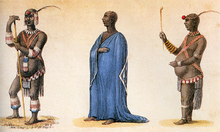Dingane
| Dingane kaSenzangakhona | |
|---|---|
| King of Zulu Kingdom | |

Dingane in ordinary and dancing dresses
|
|
| Reign | 1828–1840 |
| Coronation | 1828 |
| Predecessor | Shaka |
| Successor | Mpande |
| Born | 1795 |
| Died | 1840 (aged 45) Swaziland |
| Spouse | several wives |
| Issue | none surviving |
| Father | Senzangakhona kaJama |
Dingane kaSenzangakhona Zulu (ca. 1795–1840)—commonly referred to as Dingane or Dingaan—was a Zulu chief who became king of the Zulu Kingdom in 1828. He set up his royal capital UmGungundlovu, and one of numerous military encampments or kraals, in the Emakhosini valley just south of the White Umfolozi River on the slope of Lion Hill (Singonyama).
Dingane came to power in 1828 after assassinating his half-brother Shaka with the help of another brother, Umhlangana, as well as Mbopa, Shaka's advisor. They were traditionally said to have killed Shaka because of his increase in brutal behaviour after the death of his mother Nandi. The assassination took place at present-day Stanger.
Dingane built his capital city of UmGungundlovu in 1829 and enlarged it five years later. UmGungundlovu was built according to the characteristic layout of a Zulu military settlement (singular: ikhanda, plural: amakhanda). The ikhanda consisted of a large, central circular parade ground (isibaya esikhulu), surrounded by warriors' barracks (uhlangoti) and storage huts for their shields. The isibaya was entered from the north.
The royal enclosure (isigodlo) was situated on the southern side of the complex, directly opposite the main entrance. The king, his mistresses and female attendants (Dingane never married officially), a total of at least 500 people, resided here. The women were divided into two groups, namely the black isigodlo and the white isigodlo. The black isigodlo comprised about 100 privileged women, and within that group another elite called the bheje, a smaller number of girls, favoured by the king as his mistresses. A small settlement was built for them behind the main complex where they could enjoy some privacy. The remainder of the king's women were called the white isigodlo. These consisted mainly of girls presented to the king by his important subjects. He also selected other girls at the annual First fruit ceremony (umkhosi wokweshwama).
...
Wikipedia
